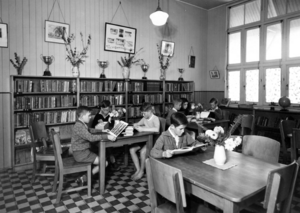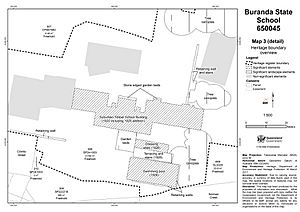Buranda State School facts for kids
Quick facts for kids Buranda State School |
|
|---|---|
| Lua error in Module:Location_map at line 420: attempt to index field 'wikibase' (a nil value). | |
| Location | 24 Cowley Street, Woolloongabba, City of Brisbane, Queensland, Australia |
| Design period | 1919–1930s (Interwar period) |
| Built | 1920–1936 |
| Architect | Department of Public Works (Queensland) |
| Official name: Buranda State School | |
| Type | state heritage |
| Designated | 28 April 2017 |
| Reference no. | 650045 |
| Type | Education, research, scientific facility: School-state |
| Theme | Educating Queenslanders: Providing primary schooling |
Buranda State School is a historic school in the Brisbane suburb of Woolloongabba. It is listed on the Queensland Heritage Register, which means it is protected as an important part of Queensland's history. The school was designed by the government and built between 1920 and 1928.
Contents
A School for a Growing Community
Buranda State School first opened in 1918 in Woolloongabba, about three kilometres from the centre of Brisbane. The school is a great example of how education in Queensland has changed over time. It still has its original timber school building, a swimming pool from 1926, and beautiful old trees.
The land where the school stands was traditionally home to the Turrbal and Jagera peoples. In the 1880s, more people began to move into the area. A railway line and electric trams made it easier to get to, and the population grew quickly. Soon, a new school was needed to serve the local families.
Schools were very important for new communities. They were a place for kids to learn and a gathering spot for everyone. Having a school was a sign that a town was growing and successful.
A Smart Design for a New School
To save money and build schools quickly, the Queensland Government used standard designs. For about 100 years, from the 1860s to the 1960s, most Queensland schools were built with timber frames. These designs were always being improved to make classrooms better for learning.
The Buranda Boys School opened on 27 September 1920 with 173 students. Its main building, called Block A, was a high-set timber building. This meant it was built on tall stumps, creating a shady play area underneath. The building had eight classrooms for 320 boys.
The design of this building was very modern for its time. Before electricity was common, getting enough natural light into classrooms was a big challenge. The designers made sure the classrooms had large windows facing south. This let in plenty of gentle light without being too glary. Desks were arranged so that light came from the students' left side, which stopped their right hand from casting a shadow as they wrote.
Life at Buranda School
The school grounds were just as important as the classrooms. In Queensland, playing outside has always been a big part of primary school. Schools had ovals, tennis courts, and gardens. Planting trees was also very popular, and schools celebrated Arbor Day every year. At Buranda, students started planting trees in 1918.
The Community-Built Swimming Pool
The school's community worked hard to raise money for new facilities. They held fairs, dances, and parties. One of their biggest achievements was building a swimming pool. It was a 25 by 10 yards (22.9 m × 9.1 m) pool with a dressing shed and a goldfish pond.
The pool was a huge community effort. Teachers, parents, and even students helped clear and dig the ground. The government supplied the materials. When it opened on 30 October 1926, the Lord Mayor of Brisbane, William Jolly, said it was a "perfect pool" that would teach children to appreciate beautiful things.
Learning to swim was seen as very important for children's health and safety. Buranda was one of several schools in Brisbane to build a pool in the 1920s.
Growing and Changing
As more students enrolled, the school needed more space. In 1928, the Boys School got a new two-storey extension with more classrooms. By 1934, the school had over 1200 students, and a separate Infants' School was opened nearby.
The school community also improved the grounds. They built shelter sheds, improved drainage, and planted lawns and flower beds. They also built stone and concrete retaining walls, some of which can still be seen today.
The School During World War II
During World War II, life at the school changed. In 1942, all coastal schools in Queensland were closed for a short time because of fears of an invasion. When they reopened, students dug long trenches in the school grounds to use as protection during air raids.
The school community was very involved in supporting the war effort. Students and staff raised money, donated items to soldiers, and attended concerts. To honour former students serving in the war, the school created two large timber Honour Boards. The first one, unveiled in 1944, listed the names of 456 former students. These boards are still at the school today.
After the War
After World War II, fewer families lived in the inner-city suburbs. Many moved to new suburbs further out. The number of students at Buranda began to fall. In 1967, the Boys, Girls, and Infants schools were all combined into one school on the original Boys School site.
Over the years, the school grounds grew larger. Some roads were closed and land was added to the school. The main timber building has also been changed, with some walls moved to create larger classrooms. Today, it is mostly used for offices and staff rooms.
A Look Around the School Today
Buranda State School sits on a large site next to Norman Creek. The main entrance is on Cowley Street. The most important historic parts of the school are in the southwest corner.
The Main Building (Block A)
Block A is a high-set timber building with a roof made of corrugated metal. It has three main sections, or wings, arranged in a symmetrical shape. A long verandah runs along the front of the building.
Many original features are still there, like the timber posts, coved ceilings, and large banks of windows that let in lots of light. The space under the building is still used as a play area. Two large Honour Boards from World War II hang in a ground floor room.
The Swimming Pool and Grounds
The 1926 swimming pool is south of Block A. Next to it is the original timber dressing shed. A series of concrete terraces and stairs lead down from the shed to the pool.
The school grounds have many interesting landscape features. There are stone and concrete retaining walls, some built in the 1920s and 1930s. There are also beautiful, large mature trees, including fig trees, that provide plenty of shade.
Why is Buranda State School Important?
Buranda State School was listed on the Queensland Heritage Register in 2017 because it is a special place for several reasons:
- It shows Queensland's history: The school tells the story of how state education has grown. The timber building, swimming pool, and landscaped grounds are excellent examples of what schools were like in the early 20th century.
- It shows classic school design: The main building is a perfect example of a "suburban timber school." Its design, with high ceilings, big windows, and undercroft play space, was very common and shows the best ideas in school architecture at the time.
- It is a beautiful place: The main building is well-designed and attractive, with fine timber details. It is a landmark in the local area.
- It has a special connection to the community: For over 100 years, the school has been a central part of the Buranda community. Generations of local children have learned there, and it remains an important place for community events.
Notable students
- Leisha Harvey, Member of the Queensland Legislative Assembly
See also
- History of state education in Queensland
- List of schools in Greater Brisbane



